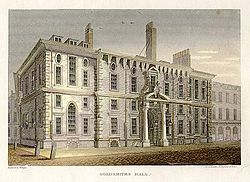Goldsmiths' Hall
| Goldsmiths' Hall | |
|
Middlesex | |
|---|---|
 Goldsmiths' Hall | |
| Type: | Livery hall |
| Location | |
| Grid reference: | TQ32228136 |
| Location: | 51°30’56"N, 0°5’45"W |
| City: | London |
| History | |
| Built 1835 | |
| For: | The Worshipful Company of Goldsmiths by Philip Hardwick |
| Livery hall | |
| Information | |
| Owned by: | The Worshipful Company of Goldsmiths |
Goldsmiths' Hall stands at the junction of Foster Lane and Gresham Street in the City of London. It has served for centuries as an assay office and the headquarters of the Worshipful Company of Goldsmiths, one of the livery companies of the City of London. It is a Grade I building.[1]
From time to time, the Master and Wardens provide for open days to visit Goldsmiths' Hall.
History
The Company has been based at this location since 1339, the present building being their third hall on the site.[2]

Little is known about the first hall. It was rebuilt in 1407 by Drugo Barentyn, a goldsmith who served twice as Lord Mayor of London.[3] The second hall was built circa 1634-36 and restored after the Great Fire of London in 1666; it was eventually demolished in the late 1820s.
Samuel Pepys viewed the funeral of Sir Thomas Vyner from Goldsmiths' Hall.[4] Pepys wore his best silk suit for the occasion, but the hall was so full of people that he left for Paternoster Square to order a new, ordinary silk suit.[4]
The third and present hall was designed by Philip Hardwick. The hall is entirely detached from neighbouring buildings, with streets on all four sides.[5] It is the second-largest of the livery halls, exceeded only by Plaisterers Hall, which stands at One London Wall.[5] Those present at the opening dinner in 1835 included the Duke of Wellington and Robert Peel.[2]
In 1941, during the Second World War, a bomb exploded in the hall’s south-west corner, but miraculously the building largely survived and was restored after the War.
Hallmarks
The process of assaying and certifying gold and silver in this hall gave rise to the term 'hallmarking'; the impression on the metal is known as a 'hallmark', which certifies the composition and weight of the gold or silver.
Outside links
| ("Wikimedia Commons" has material about Goldsmiths' Hall) |
References
- ↑ National Heritage List 1002027: Goldsmiths' Hall
- ↑ 2.0 2.1 Engel, Matthew (21 December 2012). "British institutions: livery companies". ft.com. http://www.ft.com/intl/cms/s/2/e42e19a0-47da-11e2-a899-00144feab49a.html#slide0. Retrieved 22 December 2012.
- ↑ Worshipful Company of Goldsmiths (1935). the london goldsmiths. CUP Archive. pp. 100. GGKEY:S69DNE1FJTC. https://books.google.com/books?id=3iY9AAAAIAAJ&pg=PP100.
- ↑ 4.0 4.1 The London Goldsmiths (The Worshipful Company of Goldsmiths, 1935) pages 19–
- ↑ 5.0 5.1 Kenyon 2012, p. 111-112
- Kenyon, Nicholas (2012). The City of London: A Companion Guide. London: Thames & Hudson. ISBN 978-0-500342-794.
| Livery Halls of the City of London |
|---|
|
Apothecaries • Armourers • Bakers • Barber-Surgeons • Brewers • Butchers • Carpenters • Chartered Accountants • Clothworkers • Coopers • Cutlers • Drapers • Dyers • Farmers & Fletchers • Fishmongers • Founders • Furniture Makers • Girdlers • Glaziers • Goldsmiths • Grocers • Haberdashers • Information Technologists • Innholders • Ironmongers • Leathersellers • Mercers • Merchant Taylors • Painters • Pewterers • Plaisterers • Saddlers • Salters • Skinners • Stationers • Tallow Chandlers • Vintners • Watermen • Wax Chandlers • HQS Wellington |